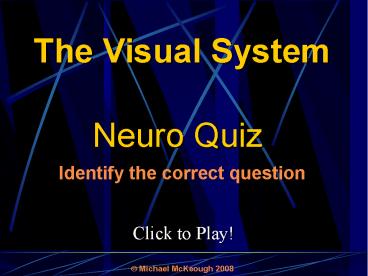The Visual System: Quiz Game - PowerPoint PPT Presentation
Title:
The Visual System: Quiz Game
Description:
Visual System Neuro Quiz Receptors 100 This is the most anterior structure of the globe (eye ball). It provides protection to the anterior chamber. – PowerPoint PPT presentation
Number of Views:646
Avg rating:3.0/5.0
Title: The Visual System: Quiz Game
1
The Visual System
Neuro Quiz
Identify the correct question
Click to Play!
? Michael McKeough 2008
2
Visual SystemNeuro Quiz
Receptors Central Pathway Physiology Misc. Pathology
100 100 100 100 100
200 200 200 200 200
300 300 300 300 300
400 400 400 400 400
500 500 500 500 500
Click category value to begin.
3
Receptors 100
- This is the most anterior structure of the globe
(eye ball). - It provides protection to the anterior chamber.
- It becomes drier and less flexible with age.
What is the cornea?
Return to Game Board
4
Receptors 200
- This aperture reflexively regulates the level of
illumination in the posterior chamber. - Under normal circumstances it is reactive to
light.
What is the pupil?
Return to Game Board
5
Receptors 300
- These receptors are sensitive to black and white.
- They are also sensitive to lines, edges and
motion. - They are the most numerous receptors in the
retina, particularly toward the periphery.
What are rods?
Return to Game Board
6
Receptors 400
- This structure produces the blind spot in the
visual field. - It covers the ganglion cells as they exit the
globe.
What is the optic disk?
Return to Game Board
7
Receptors 500
- This is the preferred region of the retina.
- It contains a 11 relationship between cones and
bipolar cells.
What is the fovea centralis?
Return to Game Board
8
Central Pathway 100
- These cells form the first-order neurons in the
central visual pathway. - They innervate both rods and cones.
What are bipolar cells?
Return to Game Board
9
Central Pathway 200
- This pathway projects from the optic chiasm to
the thalamus. - It consists of fibers from the ipsilateral
temporal hemiretina and contralateral nasal
hemiretina.
What is the optic tract?
Return to Game Board
10
Central Pathway 300
- This nucleus is the thalamic relay center for the
central visual pathway. - It contains the cell bodies of third-order
neurons.
What is the lateral geniculate nucleus?
Return to Game Board
11
Central Pathway 400
- These fibers consist of third-order neurons
projecting from the thalamus to the primary
visual cortex. - They arch around the lateral ventricle to reach
their destination.
What are the optic radiation fibers?
Return to Game Board
12
Central Pathway 500
- This sulcus contains the primary visual cortex
within the occipital lobe. - It is visible on a midsaggital section of the
brain. - Area 17 of Brodmann is located on both its
superior and inferior banks.
What is the calcarine sulcus?
Return to Game Board
13
Physiology 100
- This structure is located in the anterior chamber
and gives the eye its color.
What is the iris?
Return to Game Board
14
Physiology 200
- These are the three color sensitivities on which
color vision is based.
What are red, blue, and green?
Return to Game Board
15
Physiology 300
- The receptor potential in rods is due to the
bleaching of this substance.
What is rhodopsin?
Return to Game Board
16
Physiology 400
- This structure, in the human retina, absorbs
light after it passes by the receptors.
What is the choroid?
Return to Game Board
17
Physiology 500
- The eyes deviate in this direction when the
speaker is visually remembering images.
What is up and to the left?
Return to Game Board
18
Miscellaneous 100
- These extraocular muscles are named for the
direction in which they move the eye. - There are 4 pairs of these muscles in each eye.
What are the rectus muscles?
Return to Game Board
19
Miscellaneous200
- This type of eye movement is used to reposition
the globe from one visual target to another. - These movements occur so quickly as to be
imperceptible.
What is saccadic movement?
Return to Game Board
20
Miscellaneous300
- This clear fluid fills the posterior chamber.
What is vitreous humor?
Return to Game Board
21
Miscellaneous400
- This portion of the retina receives images from
the lateral portion of the visual field. - Fibers originating here cross the midline in the
optic chiasm.
What is the nasal hemiretina?
Return to Game Board
22
Miscellaneous500
- This portion of ambient light is what gives an
object its color.
What is the frequency of light waves reflected by
the visual target?
Return to Game Board
23
Pathology 100
- A lesion of this structure produces monocular
blindness.
What is the optic nerve?
Return to Game Board
24
Pathology 200
- This clinical test is commonly used to examine
the oculomotor system (extraocular muscles).
What are the cardinal planes of gaze?
Return to Game Board
25
Pathology 300
- This type of abnormal, involuntary eye movement
consists of slow and fast components. - It is associated with damage to the vestibular
and cerebellar systems.
What is nystagmus?
Return to Game Board
26
Pathology 400
- Age-related deficits in visual acuity
(presbyopia) are caused by this impairment. - It is caused by a progressive loss of fluid.
- It usually results in farsightedness (hyperopia).
What is impaired lens accommodation?
Return to Game Board
27
Pathology 500
- This is the most common visual impairment (field
cut) associated with stroke. - It is caused by a lesion affecting the central
visual pathway posterior to the optic chiasm.
What is hemianopsia?
Return to Game Board

